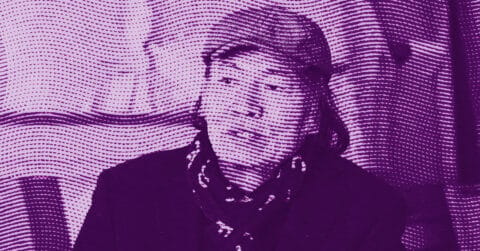Listen to me carefully, you bunch of snobs: here is an artist who, from the studios of Accra, reinvents the black portrait with a boldness that should make you ashamed of your soft certainties. Emmanuel Taku, born in 1986 in Ghana, draws on his monumental canvases a counter-history of representation, a visual manifesto that does not ask for your permission to exist. Trained at the Ghanatta College of Art and Design between 2005 and 2009, he first taught figurative drawing before realizing that teaching would not be enough to contain what he had to say. What was needed was a new language, a plastic syntax capable of carrying the veneration of black bodies without falling into the conventional traps of commemoration or illustrative activism.
The series that launched Taku onto the international scene is titled “Temple of Blackness – It Takes Two”, produced during his inaugural residency at Noldor in 2020. The title itself already constitutes a theoretical gesture: where Western museums have long erected temples to whiteness, Taku builds his own altars. His figures, draped in fabrics with screen-printed floral patterns, stand in poses that simultaneously borrow from fashion magazines and classical statuary. Their white eyes, completely devoid of pupils, transform them into demigods. This formal detail, which the artist claims as a reference to the film Man of Steel where Superman manifests his power through this ocular metamorphosis, goes far beyond cinematic homage to touch something deeper in Ghanaian cosmogonies.
The connection with auteur cinema is no coincidence in Taku’s work. It was hearing the British-Ghanaian filmmaker John Akomfrah recall his experience as a black child in English museums, which he described as “temples of whiteness” [1], that Taku found the founding concept of his work. Akomfrah, born in Accra in 1957 before emigrating to Britain, co-founded the Black Audio Film Collective in 1982 and developed throughout his career a filmic oeuvre that questions postcolonial memory, diasporic displacement, and the power structures embedded in cultural institutions. His multi-screen video installations, such as Vertigo Sea or Purple, weave together historical archives and contemporary images to create visual essays on the black condition and the environmental crisis.
For Taku, this formulation by Akomfrah, of museums as temples of whiteness, acted as a revelation. It crystallized what he had been feeling vaguely: that Western cultural spaces have historically functioned as places of consecration of a certain worldview, a certain aesthetic, a certain humanity. In response to these temples, Taku erects his own. But unlike what a superficial reading might suggest, this is not a simple binary reversal. Taku’s characters do not replace one hegemony with another; they propose a different modality of presence in the world. Their poses are not triumphant in the martial sense; they affirm a quiet sovereignty, a majesty that does not need to conquer in order to assert itself.
This architectural dimension of Taku’s project deserves close attention. When speaking of a “temple,” the artist does not merely use a metaphor: he invokes an entire tradition of thought on sacred space, on the threshold between the profane and the divine, on the function of places where a transformation of perception occurs. Temples, in all cultures, are passage spaces where the ordinary meets the extraordinary. By making his canvases fragments of this metaphorical temple, Taku transforms the act of looking into an act of devotion. The viewer is no longer in the position of the aesthetic judge evaluating a work but that of the pilgrim entering a sacred space. This inversion of power relations in the relationship between the artwork and its audience may be the most subversive aspect of Taku’s work.
Akomfrah’s cinema and Taku’s painting also share a layered approach to the image. With Akomfrah, multiple screens and the superposition of temporalities create a visual density that resists linear reading. With Taku, this stratification occurs through the accumulation of techniques: acrylic, screen printing, newspaper collages, textiles. The floral fabrics that dress his figures are not mere ornaments; they carry a history, that of the artist’s sister, a seamstress, the commercial exchanges between India, Great Britain, and Africa, the hybrid identities shaped in these circulations. The paisley pattern that Taku particularly favors embodies this complexity: originating from Persia and India, popularized in Scotland, adopted by Western countercultural movements, it itself carries the map of cultural appropriations and reappropriations.
But there is something else in Taku’s work, something more intimate and more American in its genealogy: the influence of positive thinking and the New Thought Movement as it developed in the 1920s. The artist readily cites The Secret of the Ages, a book published in 1926 by Robert Collier [2], as having changed his life. This book, which sold over 300,000 copies during the author’s lifetime, belongs to that literary tradition of personal development that promises access to unlimited power through mastery of the subconscious mind. Collier, nephew of the founder of Collier’s Weekly magazine, develops a psychology of abundance based on desire, faith, and visualization.
This reference might be surprising. What place does such a work, often criticized for its naive optimism and fierce individualism, have in the economy of a work that presents itself as a project for the collective restitution of dignity? The answer lies precisely in the way Taku rearticulates Collier’s propositions. Where The Secret of the Ages addresses isolated individuals seeking personal success, Taku transposes these principles into a communal and decolonial register. Visualization becomes the creation of counter-hegemonic images; faith in one’s own possibilities transforms into an affirmation of black beauty and power long denied; the power of the subconscious becomes the capacity to reinvent oneself beyond the scripts imposed by colonial history.
Taku himself explains it in these terms: “If you can think it, then you can have it” [3]. This phrase, directly inspired by Collier’s rhetoric, takes on a political dimension in the artist that it did not have in the American author. To think of black bodies as divine entities, to visualize them in poses of power, to drape them in sumptuous fabrics, is to operate the transformation that Collier promised: to bring into being through thought that which reality still refuses. The 1926 book and the 2020 paintings share this conviction that imagination is not mere fancy, but a creative force capable of reshaping reality.
However, there is a difference: with Collier, the transformation remains individual and material; with Taku, it is collective and symbolic. The artist’s figures are never alone. They go in pairs, in groups, forming configurations where bodies intertwine and respond to each other. This insistence on duality and multiplicity finds its source in a Ghanaian proverb that Taku regularly evokes: a single broom breaks easily, but bound together, brooms become unbreakable. Consolidation, synergy, unity: this is what these compositions seek, where anthropomorphic silhouettes blend into one another, creating hybrids where it is no longer quite clear where one body begins and another ends.
This aesthetic of fusion contrasts with the hyper-individualism of the American New Thought Movement. Taku reclaims the conceptual tool, the power of thought, creation by visualization, but redirects it towards communal ends. His temples do not celebrate solitary heroes but collectives, solidarities, alliances. In this, he performs a cultural translation: personal success becomes collective emancipation. This subversion operation demonstrates remarkable strategic intelligence. Rather than outright rejecting the conceptual tools produced by the dominant American culture, Taku bends them to his own purposes.
The artist’s monumental canvases, some measuring up to 3 meters wide, physically impose their presence. They do not allow themselves to be viewed distractedly; they demand that one stand before them, that one raise the eyes toward these larger-than-life figures. This monumentality is part of the reversal strategy: where black bodies have historically been reduced, objectified, fragmented, Taku amplifies them, magnifies them, makes them unavoidable. The screen printing that adorns the garments adds an ornamental dimension that refuses the austere sobriety often associated with “serious” art. These exuberant floral motifs, these saturated colors, this refusal of formal asceticism: all of this constitutes a joyful, almost insolent affirmation of the right to beauty and sumptuousness.
Collectors have not been mistaken. In 2022, with nearly one million euros worth of works sold at auction, Taku became the third most successful Ghanaian artist of his generation on the global market. A painting made during the Noldor residency set his personal record at 250,000 euros in March 2022. These figures, which might be deemed crude to mention in a critical analysis, nevertheless say something important: the market, despite all its flaws, recognizes here the power of a work that makes no concessions. Taku has not watered down his message to please; on the contrary, he has radicalized his positions, and it is precisely this uncompromising stance that attracts.
Because deep down, what Taku offers is an escape from the compassion-driven regime of representation that has long characterized Western art’s approach to Black subjects. His figures call for neither pity, nor sanctimonious solidarity, nor moral indignation. They don’t need your empathy. They are self-sufficient, sovereign and unreachable in their supernatural splendor. This inaccessibility, signified by the blind white eyes that don’t really look at you, constitutes a refusal of the usual scopic pact. You can contemplate them, but they do not contemplate you in return. They exist in a parallel sphere, that of the temple they inhabit, and you remain outside, an admitted but uninvited spectator.
This aesthetic position ultimately echoes that of Akomfrah in his installations: creating contemplative spaces where the Western spectator is decentered, where his gaze no longer organizes the world. In the dark rooms where Akomfrah’s videos unfold, as in front of Taku’s canvases, one experiences an alterity that is not reducible, not explainable, that simply asserts itself. It is this ontological dignity, this full and entire presence, that both artists, by different means, strive to make visible. Akomfrah’s cinema and Taku’s painting thus form a Ghanaian diasporic constellation, a dialogue across the Atlantic between two generations of artists who refuse to occupy the roles assigned to them.
This is not about succumbing to the hagiographical temptation that threatens every art critique as soon as it addresses issues of representation and justice. Taku’s work has its limits, its dark zones. One could question the permanence of the human figure when so many contemporary artists explore abstraction or installation. One could also question the relative formal uniformity of a production that, series after series, renews the same compositional choices. But these reservations count little against the evident necessity: these images were missing, and now they exist. They fill galleries in Brussels, New York, and Hong Kong. They circulate in auction houses. They enter museum collections. They produce what Taku had visualized, following Collier’s precepts: they transform the possible into the real.
The temple that Emmanuel Taku builds is not a static monument; it is a permanent construction site, an architecture always becoming. Each new canvas adds a stone to the edifice, widens the sacred space, welcomes new figures into the pantheon. And in doing so, it imperceptibly transforms the contemporary art landscape, shifts the lines, and makes the maintenance of old hierarchies a little more difficult. It is this strategic patience, this confidence in the accumulative power of images, that makes Taku not a smashing iconoclast but a determined builder. He does not destroy the temples of whiteness; he patiently, methodically erects his own, knowing that their mere existence is enough to question the hegemony of the first. Perhaps the most precious lesson to draw from this work is that counter-history is written less in frontal confrontation than in the patient construction of visual alternatives, in the obstinacy to make exist what had no right of citizenship. And that existence, once established, becomes irreversible.
- John Akomfrah, reference mentioned by Emmanuel Taku during his interview with Gideon Appah for the Noldor Residency, 2020, regarding museums as “temples of whiteness”.
- Robert Collier, The Secret of the Ages, Robert Collier Publications, 1926.
- Emmanuel Taku, interview with Fashion Week Daily, 2021.
















